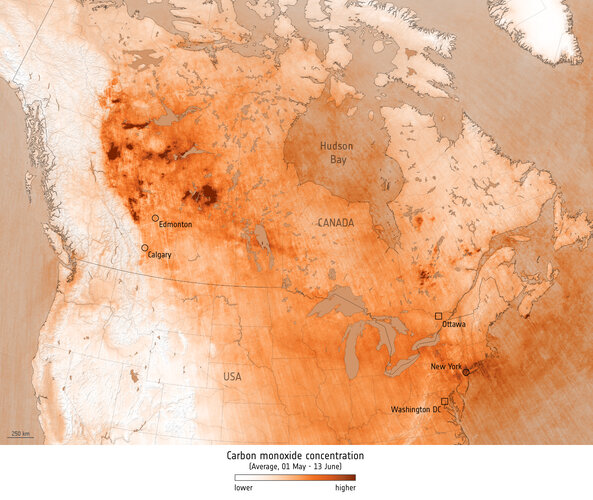Canada’s wildfire season begins
Wildfire season has arrived in full force in Canada, prompting evacuation orders and alerts in several towns in British Columbia and Alberta due to the danger of uncontrolled blazes.
Hazardous smoke from the fires has also triggered air quality alerts in Canada and the northern US. Satellite technology, including the Copernicus Sentinel-5P satellite and ESA’s Fire Atlas, plays a crucial role in monitoring these wildfires.
The 2023 wildfire season in Canada was one of the worst on record. Over the course of the fire season that started early and ended later than usual, blazes burned an estimated 18.4 million hectares. The impact on the environment, especially air quality in both Canada and the US, was profound.
With the 2024 wildfire season already in full swing, Canadian authorities are bracing for a challenging summer.
Wildfire season in Canada typically runs from April until September or October when cooler temperatures dampen fire activity. The early onset of these wildfires, caused by unseasonably warm temperatures and dry conditions, has raised concerns about a potentially prolonged and severe fire season ahead.
According to the Canadian Interagency Forest Fire Agency, there are around 130 wildfires currently burning across Canada, mostly in British Columbia and Alberta.
Data from Copernicus Sentinel-5P reveals the extent of air pollution caused by these wildfires. Equipped with the Tropomi instrument, the satellite provides high-resolution data on air quality by measuring gases and aerosols, including air pollutants such as carbon monoxide, nitrogen dioxide and particulate matter.

The animation above shows the concentration of carbon monoxide in early May. The extremely high concentrations, depicted in dark shades of orange, can be linked to active fires during this time period.
Smoke from the fires can travel vast distances, degrading air quality far from the source of the flames.
ESA’s World Fire Atlas, an essential tool in wildfire monitoring, utilises data from the Copernicus Sentinel-3A satellite to detect and map active fires globally.
Working like a thermometer in the sky, the Sea and Land Surface Temperature Radiometer (SLSTR) on board Sentinel-3 measures thermal infrared radiation to take the temperature of Earth's land surfaces which is used to detect the fires.
The data, which is represented in ‘pixels’ indicate that 258 fires have been detected in Canada in 2024 (data up to 13 May). In contrast, during the 2023 wildfire season, the Atlas detected 19 487 wildfires.
As the wildfire season progresses, ESA’s World Fire Atlas continues to be a valuable resource in tracking new fire outbreaks.















 Germany
Germany
 Austria
Austria
 Belgium
Belgium
 Denmark
Denmark
 Spain
Spain
 Estonia
Estonia
 Finland
Finland
 France
France
 Greece
Greece
 Hungary
Hungary
 Ireland
Ireland
 Italy
Italy
 Luxembourg
Luxembourg
 Norway
Norway
 The Netherlands
The Netherlands
 Poland
Poland
 Portugal
Portugal
 Czechia
Czechia
 Romania
Romania
 United Kingdom
United Kingdom
 Slovenia
Slovenia
 Sweden
Sweden
 Switzerland
Switzerland































